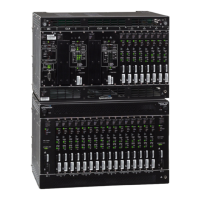097-55501-01 Revision M – January 2009 TimeHub 5500 User’s Guide 31
Chapter 1 Description
Alarms
NTP Server Cards
The Network Time Protocol (NTP) synchronizes the time of a computer client or
server to another server or reference time source, such as a GPS receiver or local
timing source. The timing is distributed over a TCP/IP network. The Symmetricom
TimeHub with the NTP Server card and Output Connector panel provides NTPv4
functions, as described in the draft IETF NTPv4 specification. The TimeHub acts as
an NTP server, and distributes an accurate time packet to clients connected to it via
an Ethernet network. To minimize traffic issues, the NTP packets are transmitted on
a network separate from the TimeHub management network.
The TimeHub Management card must have firmware Revision 4.0.3 or higher in
order to operate.
For more information on the TimeHub NTP Server cards, see NTP Server Card, on
page 70.
Alarms
Alarms are indicated by shelf and card status LEDs, and TL1 messages are
reported via the local or LAN communication interface. In addition, contact closures
provide for remote indication of alarms on the shelf.
There are two types of alarms associated with the TimeHub 5500: shelf and system.
A shelf alarm is one that occurs from within the TimeHub 5500 shelf, and a system
alarm is one that is sensed via one of the external alarm wire-wrap inputs on the
input/ alarm card. If an alarm is sensed on any of these 10 external alarm inputs, it
appears as a “System” alarm on the Management card front panel.
If simultaneous alarms occur with different severity levels, the front panel LEDs
indicate only the one with the highest severity. For example, if both MAJOR and
MINOR shelf alarms are present, only the MAJOR alarm LED is lit in the “Shelf”
alarm row. In this case, if the MAJOR alarm ends, then the MINOR alarm LED lights
(assuming that the source of that alarm is still present) since this is now the highest
severity shelf alarm.
If there is a MAJOR shelf alarm and a MINOR system alarm (any of the external alarms
in 7 to 10 range) then the MAJOR LED is lit for the shelf alarm row and the MINOR LED
is lit for the system alarm row. In other words, it is possible to have alarm LEDs of
different severity illuminated if one is a shelf alarm and the other a system alarm.
In all cases, all current alarms are reported via the TL1 command interfaces (serial
and network) and can be retrieved at any time using the RTRV-ALM query (see the
TL1 Reference Guide). If there are multiple alarms of the same and different
severity, all are included in the RTRV-ALM response.

